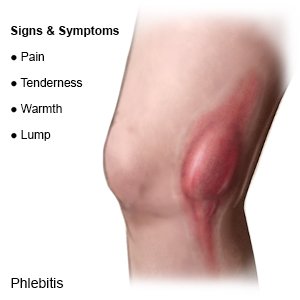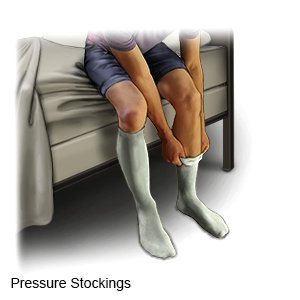Phlebitis
Medically reviewed by Drugs.com. Last updated on Apr 6, 2025.
What is phlebitis?
Phlebitis is inflammation of the wall of your vein. Inflammation may be caused by damage to or infection of your vein. Phlebitis may occur in a vein in your arm or leg. Symptoms include pain, redness, and swelling near the vein. Symptoms may appear when you are receiving an IV medication, or 48 to 96 hours after you receive the medicine.
 |
What increases my risk for phlebitis?
- An IV catheter placed in a vein in your arm or leg
- IV injections of amiodarone, vancomycin, ciprofloxacin, or chemotherapy medicines
- A condition that affects your blood vessels, such as varicose veins or venous insufficiency
- IV drug abuse
Drugs used to treat this and similar conditions
Oxycodone
Oxycodone is an opioid analgesic used to treat moderate to severe pain; it has a high potential for ...
Ozempic
Learn about Ozempic (semaglutide) for type 2 diabetes treatment, weight management, cardiovascular ...
Acetaminophen
Acetaminophen is a widely used pain reliever and fever reducer for conditions like headaches ...
Ibuprofen
Ibuprofen (Advil, Motrin) treats minor aches and pains caused by the common cold, headaches ...
Gabapentin
Gabapentin is an anti-epileptic drug, also called an anticonvulsant. It is used to treat some types ...
Lasix
Lasix is a loop diuretic used to treat fluid retention from heart, liver, or kidney conditions, and ...
Hydrocodone
Hydrocodone (Hysingla ER and Zohydro ER) is used for around-the-clock treatment of severe pain ...
How is phlebitis treated?
Medicines may be given to decrease pain and swelling. Your IV catheter will be removed. Do the following to manage your symptoms:
- Apply a warm compress to your vein. This will help decrease swelling and pain. Wet a washcloth in warm water. Do not use hot water. Apply the warm compress for 10 minutes. Repeat this 4 times each day.
- Elevate your leg or arm above the level of your heart as often as you can. This will help decrease swelling and pain. Prop your leg or arm on pillows or blankets to keep it elevated comfortably.
- Wear pressure stockings if directed. Pressure stockings improve blood flow and help decrease pain and swelling. Pressure stockings can also help decrease your risk for blood clots in your legs. Wear the stockings during the day. Do not wear them overnight when you sleep.

- Do not inject illegal drugs. Talk to your healthcare provider if you use IV drugs and need help to quit.
When should I seek immediate care?
- Your leg or arm turns pale or blue.
- Your leg or arm feels hot or cold.
- Your arm or leg feels warm, tender, and painful. It may look swollen and red.
When should I contact my healthcare provider?
- You have a fever.
- You have more pain, swelling, or warmth near your vein.
- Your symptoms do not improve within 72 hours.
- You have questions or concerns about your condition or care.
Care Agreement
You have the right to help plan your care. Learn about your health condition and how it may be treated. Discuss treatment options with your healthcare providers to decide what care you want to receive. You always have the right to refuse treatment. The above information is an educational aid only. It is not intended as medical advice for individual conditions or treatments. Talk to your doctor, nurse or pharmacist before following any medical regimen to see if it is safe and effective for you.© Copyright Merative 2025 Information is for End User's use only and may not be sold, redistributed or otherwise used for commercial purposes.
Further information
Always consult your healthcare provider to ensure the information displayed on this page applies to your personal circumstances.
